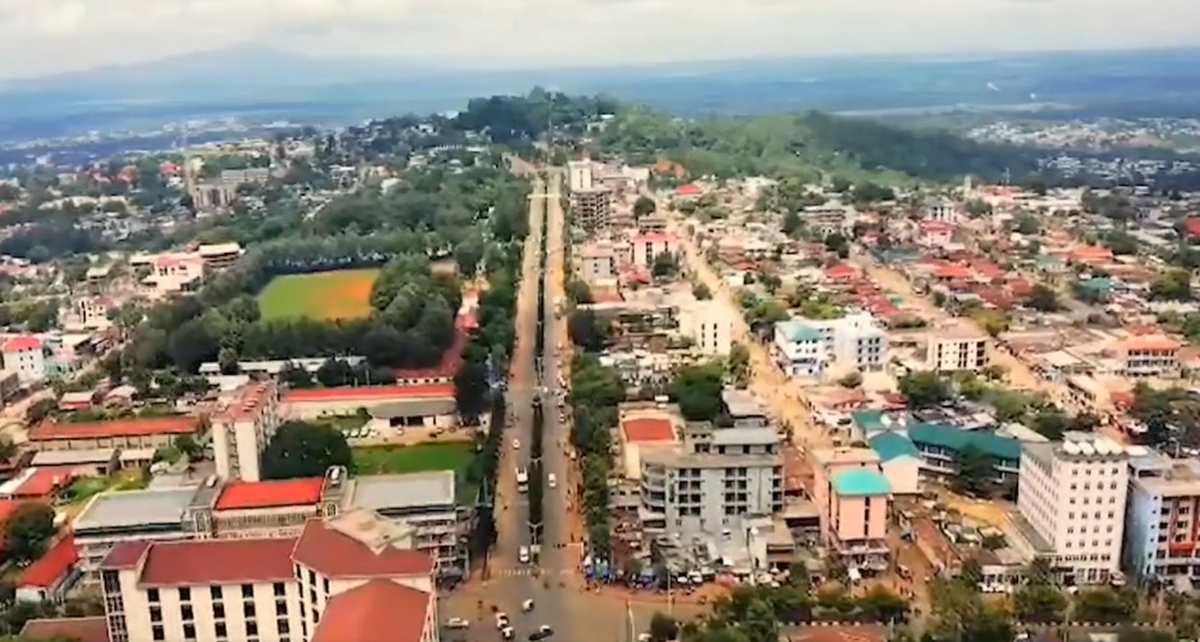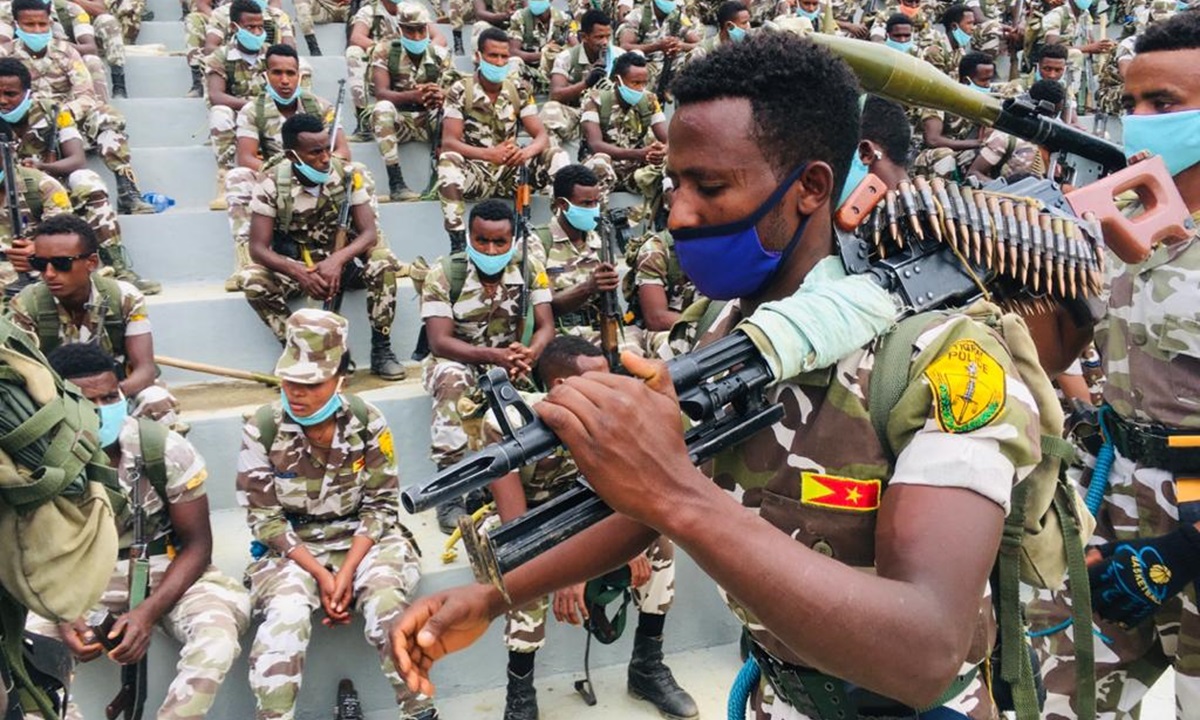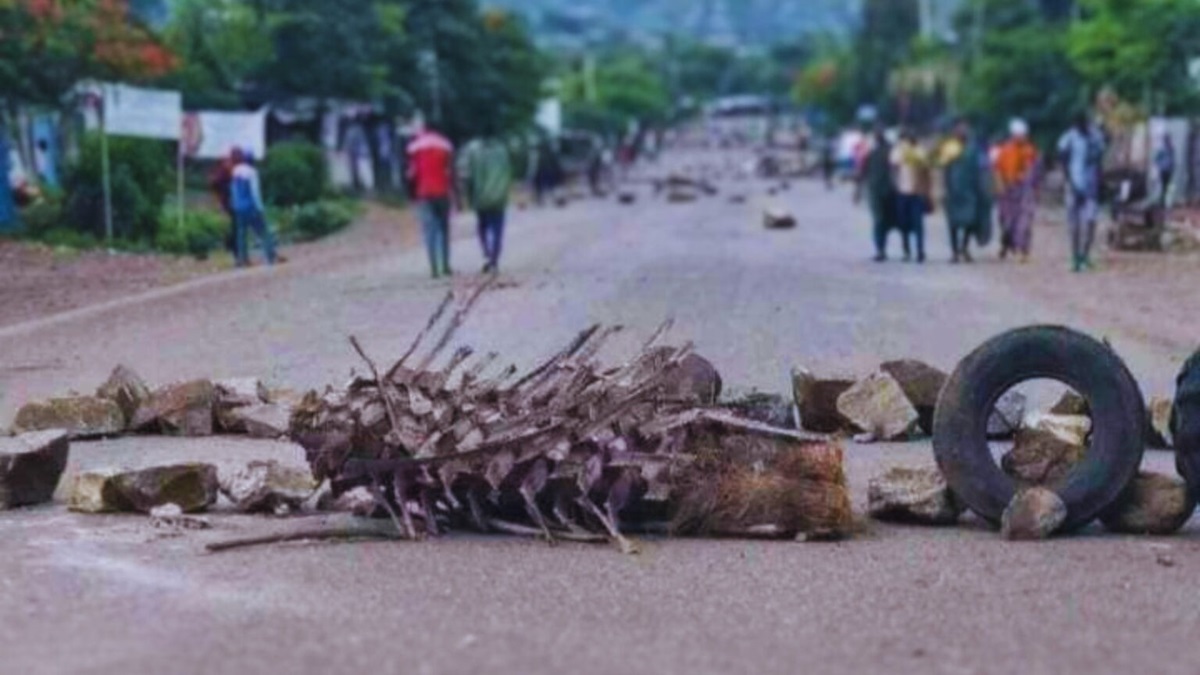In-depth Analysis: Addis Mayor’s latest remark reveals widening divergence between Amhara, Oromo ruling class of Prosperity Party. What is at stake?
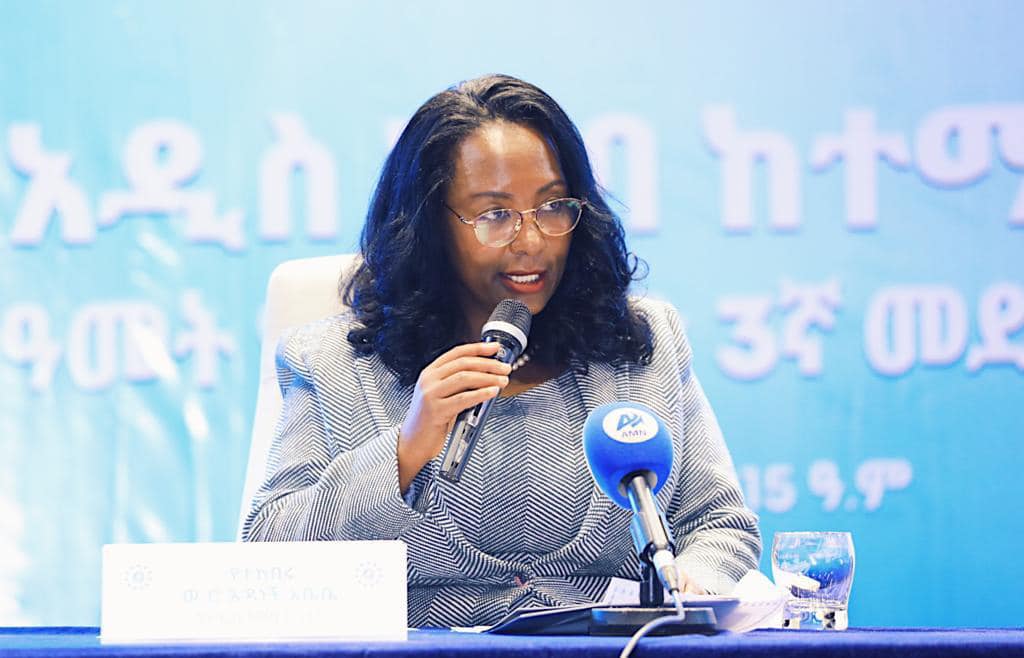
Addis Abeba – Addressing the regular assembly of the city’s council, Addis Abeba mayor Adanech Abiebie spoke on Tuesday about the challenges she said her administration has had to grapple with in recent days: “the youth are flocking to the capital from some regional states with the intention of overthrowing legally elected government”, the Mayor said.
Addis Abeba Police Commissioner, Getu Argaw, reinforced the mayor’s remark with statistics when he said 64 percent of the said youth who came to the city were from the Amhara region, whereas 24 percent were from the Southern Nations, Nationalities and People’s (SNNP) and 14% from the Oromia regions respectively.
Commenting further on the challenges her city faces, Mayor Adanacne added that sleepless “forces of destruction” are out to “destroy our peace,” Mayor Adanech said, “the movement to confuse and disillusion the people, especially the youth, by inciting them to destruction through false propaganda is unacceptable as it does not benefit anyone,” she said, without stating who she was referring to.
It didn’t take long for her remarks to spark uproars and criticism from opposition political parties, most notably National Movement of Amhara (NaMA) and the Ethiopian social media space. NaMA was quick to call out the Mayor’s remark as “dangerous, divisive and genocidal incitement” and called the Mayor to be held accountable for her remarks.
This latest controversy came in the backdrop of reports of repeated incidents whereby travelers, particularly from the Amhara region, were denied access to the city upon reaching the borders of Oromia regional state, which they have to cross to get to Addis Abeba.
Yelikal Kefale (PhD) president of the Amhara regional state, addressing the regional council said last week that the right to free movement is stated in the constitution and that it needs to be upheld. “We are entering Sudan freely, and some other countries visa-free, we shouldn’t be told to stop while moving in our own country,” the president said.
Taken together, this signals yet another point of rupture in the ever deepening divergence between the two main stakeholders of the ruling Prosperity Party, the Oromia and the Amhara PPs and their respective constituencies.
The issue was the topic of the last cover story by Addis Standard print magazine under the title of “Transactional alliance and Ethiopian state: From Crisis to cover up”.
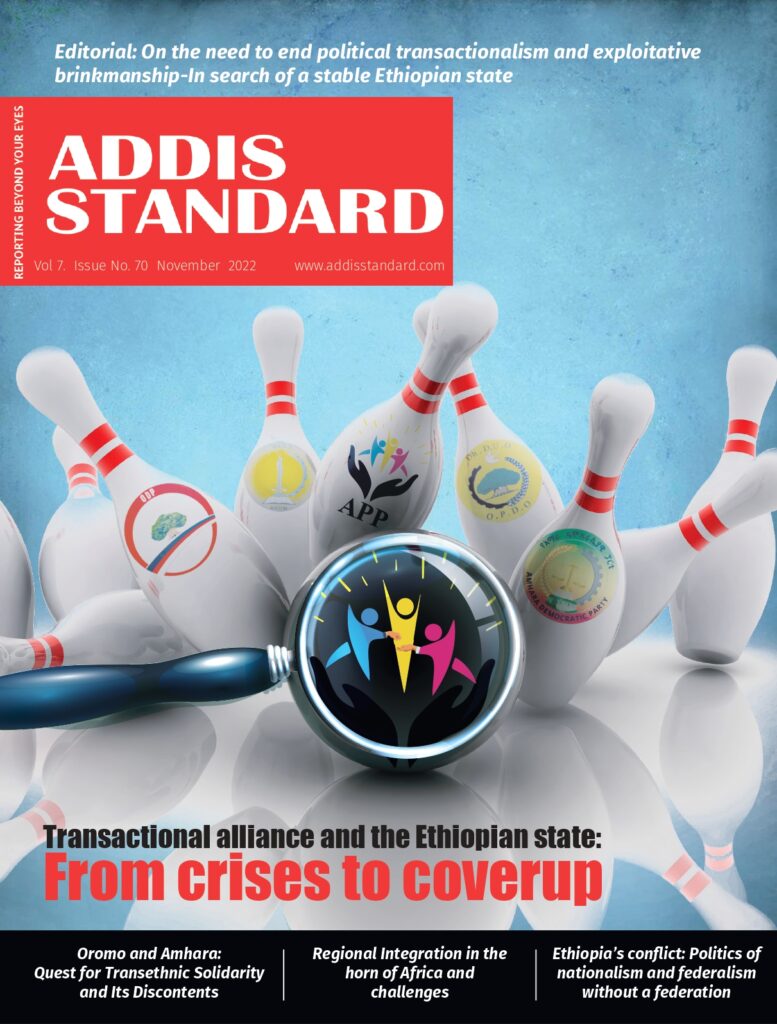
Transactional alliance and Ethiopian state: From Crisis to cover up
Around mid-morning on Wednesday 21 September, the Amhara Regional State Police Commission broke the news of the detention by regional police forces of Zemen Kassie, a well-known Fano militia leader in Amhara region, who is affectionately referred to by his large fans as “Patriot Fano Zemene.”
According to Commander Kindu Wonde, Deputy Head of Tactical Investigation Department of the Amhara Region Police Commission, Zemene was taken into police custody in Bahir Dar city, the capital of the regional state, from his hideout at a private house in the city’s Kebele 03 following “tips from community members” to the police.
Kindu said Zemene is suspected of multiple “criminal activities” including “organizing an illegal group” and running “illegal checkpoints” in the region to “impede and destabilize” the free movement of civilians. He also said that more than 500, 000 birr was found in Zemene’s possession along with other exhibits seized from the scene of the arrest, which are now under police investigations.
The detention of Zemene is the latest in a string of similar arrests by security forces that saw an estimated 12, 000 Fano militias, a non-state armed group from the Amhara region, placed under police custody. In two announcements made in May and July this year, the federal and Amhara regional state governments security officials admitted detaining 4,552 and 5, 804 “extremist Fano” members respectively.
The official version of the story is that they are detained for attempting “to spread violence,” and that they include those who “were convicted by a court but were at large, and those who were wanted for murder.” They are not to be mistaken with the real Fano who “fought against” Tigrayan forces during the law enforcement campaign “in the northern part of our country” and were “helping the security forces” including “the national defense and other security forces, [and] have contributed to the peace and security in the region today and continued this good work.” This was the explanation given in July by the Ethiopian joint security and intelligence task force, which is composed of the National Intelligence and Security Service (NISS), Ethiopian National Defense Forces (ENDF), the Federal Police Commission, and Information Network Security Administration (INSA).
For the Amhara-centered, non-state owned or affiliated online and satellite-based media outlets, as well as vocal critics of the Prosperity Party (PP) led government, the state’s version of this story does not in any way hold water. The popular view among this group is that this is part of the increasing plot by the Oromo-dominated P.P. to dislodge a meaningful Amhara participation in Ethiopia’s post-EPRDF political dispensation.
At the core of the list of accusations by the regional police against Zemene is the one that he is accused of “organizing an illegal group,” which signaled the “collective criminalization” of the Fano militia structure. Zemene and many others were otherwise engaged in organizing the Fano with the implicit and explicit support of the ruling party both at federal and regional levels. “This is the practical implementation of the decision by [PM] Abiy and co. to criminalize the works of organizing the Fano,” commented one popular Amhara-centered media host. That the Fano militia are accused of conducting some of the most egregious human rights abuses, including charges of aiding and abetting the ethnic cleansing in western Tigray since the war broke out in Tigray in November 2020, is not a factor in this explanation.
The federal and Amhara region security forces explanation “is not a version of the story one could simply deploy to convince popular Amhara views,” agrees a close observer of Ethiopia’s current political affairs who wants to remain anonymous. In an interview for this article, he told Addis Standard that “the unfolding political dynamics within the PP coalition, particularly between the Amhara and Oromo chapters of the party, is something anyone who is interested in Ethiopia’s politics should watch closely.”
Increasing numbers of Amhara opinion makers and influencers who are critical of the relationship between the Oromo and Amhara politicians of the ruling elite “resent the fact that the Amhara chapter of the ruling party appear to be not politically strong enough to oust PM Abiy and his Oromo allies; nor do they think they should be the second best within the PP,” our interviewee said, adding that unlike other chapters of the PP, such as its southern region coalition, increasing numbers of Amhara-centered critics do not want to see their political class becoming the smokescreen or mere accessory to the Oromo political elites’ attempt at consolidating politics. “Politically, this puts the Amhara chapter of the ruling PP at an awkward position and in a mix of unstable political alliance with the Oromo chapter.”
“The tactical alliance was an opportune moment for both parties as they suffered from lack of legitimacy in their respective regions”
For many, both the arrest of Fano Zemene and the massive crackdown against thousands of Fano militia members is the making of the federal government led by Prime Minister Abiy Ahmed.
How did we get here? And what else is fueling this rupture?
Back to the genesis. Reform the EPRDF, not
The entanglement between the two dominant members of the current P.P -led government can be traced to the months preceding the ascendance of Abiy Ahmed as Prime Minister in April 2018. As popular anti-government protests that began in the Oromia region in May 2014 spread to Somali, Amhara, and Southern regions and tested the limits of the EPRDF-led government, a tactical alliance between two of the four main parties that made of the EPRDF: the Oromo People’s Democratic Organization (OPDO) and the Amhara National Democratic Movement (ANDM) was formed single-handedly focused on dislodging the TPLF, which was resented for having wielded an oversized influence within the ruling party.
Both OPDO and ANDM took advantage of the culmination of the popular anti-government protests and the political struggle by the Oromo youth (Qeerroo) which had intensified especially after 2016.
“The tactical alliance was an opportune moment for both parties as they suffered from lack of legitimacy in their respective regions,” said our interviewee, “and whatever they did politically was beyond scrutiny and second guessing. The widely held focus was on how to get rid of the TPLF, not on how to progress the alliance into a strategic alliance with a view to create the foundations for a stable political order.”
Despite there being too much desire for a reformed EPRDF and a transition to democracy, critical questions remained unasked. The birth of a tactical alliance of a sort, later on named as “Oro-Mara” or at times defined as “Team Lemma” emerged within the broader EPRDF It became a synonym, including within the international community, with the rise of some reformist elements from within the ruling party who embraced the people’s demand for change and identified themselves as “agents of change.”
“The role and hope given to ‘Team Lemma’ in bringing reform and democratic transition in Ethiopia was so high it became impossible to question it,” said our interviewee.
Lemma Megerssa (Ph.D), leading the Oromo Democratic Party (ODP) [formerly OPDO] earned popular trust as he boldly denounced extreme measures by the federal government’s security apparatus against civilian protesters and assured his alliance with the people of Oromo and Amhara. Lemma’s call was quickly answered by the Amhara Democratic Party (ADP) [formerly ANDM], most notably by Gedu Andargachew, who was then the President of the Amhara region.
“What held the two parties together under the umbrella of the EPRDF was its disciplinarian party principles, it was never the concept of common values…”
As both regions were undergoing the turmoils of popular protests and collective de-legitimization of each party by their respective constituency, there was intimate solidarity to exchange between the two regional state presidents, Lemma and Gedu.
In real politics, however, the ideological divergence between the two parties over the politics of running the Ethiopian state could not have gotten wider. “What held the two parties together under the umbrella of the EPRDF was its disciplinarian party principles, it was never the concept of common values and common agenda, such as political settlements or the shared values between the political elites of two national groups,” said our interviewee.
Regardless, the leaders and senior members of the two parties remained together in the wake of the official dismantling of the EPRDF as a governing coalition, and the subsequent rebranding and birth of the Prosperity Party in November 2019.
“Other than the desire for the dividends of political power these two parties share zero common agenda and shared values needed to establish a stable political order such as what defines citizenship, the concepts of state society relationship, or how should the state distribute rent and state power not just among their respective national groups but to all national groups, or what should the shape and identity of the Ethiopian state look like,” our interviewee probs.
These are questions that transcend the tactical alliance between the OPDO and the ANDM that both effectively concealed when joining hands to dislodge the “common enemy”, the TPLF, and pretended to bring an end to the authoritarian rule of the EPRDF-led government.
Enter Finfinne/Berera
“From the foregoing, despite some similarity, the divergence between OPDO’s and ANDM’s paths is not insignificant,” wrote Biniyam N. Menberework, a political analyst and a close observer of the dynamics within the latter. In an article he published on Addis Standard in April 2018, Biniam explained this “divergence” from the vintage point of the challenges of being the ANDM in an alliance with the OPDO in the context of “programmatic orientation and organizational forms.” Such alliance requires the former to become “an ethnic-based organization of the Amhara people,” and to consider “the Amhara ruling class to be a national oppressor for about a century” and to espouse to “ethnic-based federal arrangement, which promises the unconditional rights of ethnic groups to self-determination including secession, among others.”
Ideological divergence is just one, however. There are real time issues with deadly consequences that the two parties carried over to the political field during the rebranding of the EPRDF into PP with no visible attempt to reach a political settlement at addressing them; as time passes by, the gap in their differences show no sign of ebbing.
The contest over the legal status and the control of the city of Addis Abeba may prove to be the most consequential. The city’s official name goes by Finfinne for the Oromo, whereas in various instances, the Amhara political elite make reference to Berera as the city’s original name.
In mid-August this year, the city administration,led by Mayor Adanech Abiebie, an Oromo, legalized an administrative demarcation identifying districts surrounding the city of Addis Abeba and the Oromia Special Zone Surrounding Finfinne, a special zone established in 2008 with the view to develop a legal framework to regulate the administrative expansion of the city of Addis Abeba in the the Oromia region.The City Administration said it was done following the completion of a new study.
Mayor Adanech Abiebie hailed the decision as “historic”, and said an agreement has been reached for Addis Abeba city administration to continue to administer the areas it was administering before, whereas the Oromia Special Zone Surrounding Finfinne will administer areas where condominiums were built inside its administrative areas, financed by the Addis Abeba city administration together with prospective homeowners.
For the mayor’s office and the federal government, which weighed on the decision with its own praise, this was a major milestone that puts one of the longstanding bitter chapters emanating from the ever increasing, out of control expansion of the city of Addis Abeba into the Oromo farmers’ land to closure. The 2015 Oromo protests that eventually brought in the demise of the EPRDF was first triggered by the Addis Abeba Master Plan, which would have seen the city expand and annex territories under the jurisdiction of the Oromia Special Zone Surrounding Finfinne.
The decision to implement the administrative demarcation came in the backdrop of the continued tussle for ownership status of Addis Abeba between the Oromo and Amhara political elites within the ruling PP.
Most importantly, it came a month after a heated controversy and stiff resistance piled up against the Mayor’s office both from the Amhara PP officials and Amhara-centered opposition parties and politicians over the decision by the city’s education bureau to introduce Afaan Oromoo as one curriculum, hoist the Oromia region’s flag alongside that of Ethiopia’s official flag in some school compounds, and to have the Oromia regional state’s anthem sung in selected schools in Addis Abeba city.
In some schools in the city, the decision was met with resistance, including physical altercations. For many critics, this was the inarguable justification of the Oromo PP’s attempt to “Oromize” the city. During the City Council’s regular session held in mid-July, Mayor Adanech was confronted by Amhara P.P. Council member, Sisay Mengiste (PhD). Sisay said he had “no problem” with the decision, nevertheless it will not only be a potential threat to security, but also lacked the legal framework and formidable assessment on its advantages and disadvantages. Addis Abeba is home to other nations and nationalities, he said, as well as the seat of the federal government.
His challenges did not sit well with Mayor Adanech, who stated the fact that unlike other regional states, the fact remains that Addis Abeba is the capital city of the Oromia regional state.
“It is true that Addis Abeba is the capital city of Ethiopia where different nations and nationalities live in…it is true. [But[ unlike other regional states, [Addis Abeba] is the capital city of the Oromia regional state, it has served as the capital city of Oromia for the last 30 years. It is an issue in our constitution,” she said. Her remarks sparked a widespread uproar from multiple commenters and media personalities who dismissed her assertions as “out rightly unconstitutional.”
A second interviewee who spoke with Addis Standard for this article, and like the first who also wanted to remain anonymous, commented on this specific tension. “There is nothing as revealing the irreconcilable historical, constitutional and political differences between the two parties as this particular episode is,” he said.
Between the months of September and July, both topics that created the friction: i.e. the administrative demarcation and the introduction of Afaan Oromo curriculum, the flag and anthem of Oromia region in selected schools in the city went on.
“The two parties don’t see each other eye to eye over the matter, let alone reach a consensus,” our interviewee said. He believes, “it is far from over; in the absence of political settlement and consensus between these two parties, it is hard to call it anything else but a political time bomb.”
A fresh layer of trigger waiting to detonate this “political time bomb” was recently added to the mix. In Early August this year, authorities in the Amhara regional state sounded the alarm through several press statements that passengers traveling to Addis Abeba from destinations in Amhara region, including Desse City, South and North Wollo Zones and Wag Hemra Zone were subjected to “extreme harassment and abuse” when they arrived in Sheno City, in Oromia Region to enter Addis Abeba. Amhara region authorities assert that unless the passengers were holders of Addis Abeba resident IDs, they were not welcome to enter the city. Transportation services from Debre Berhan to Addis Abeba have also been suspended for the same reason. Thousands of civilian travelers, including those who were coming to the capital seeking medical attention and those who were preparing for their wedding parties were subjected to days of blockades.
Furthermore, the chairman of North Shewa Zone Transport Association, Gebre Egziabher Tesema, decried that vehicles with Amhara region license plates were being prevented from accessing the capital city for work due to denials by traffic policemen stationed in the Sandafa area of Oromia region.
A similar blockade of travelers happened in early October but was explained away as part of reducing traffic congestion in the wake of the Oromo Irreechaa celebrations in the city.
For popular Amhara-centered opinion makers and media outlets, this was the Oromo PP- engineered system of “apartheid” on Addis Abeba. The federal and regional governments of the two regions neither condemned, nor explained the incidents.
Security: from the thorny Oromo Special Zone in Amhara region…
In April 2021, exactly three years after the Oro-mara tactical alliance propelled PM Abiy Ahmed to power, the Addis Standard journalists were barely able to collect their breath covering region-wide protests in Amhara regional state which were called to collectively denounce the killings and displacement of Amhara communities in various parts of Ethiopia, most notably the Oromia region. On the third day of the protest, thousands of people came out on the streets of Debre Birhan, in the North Shewa zone of the Amhara regional state. Protesters were chanting “enough.”
In a statement capitalizing on the protests, the region’s communication bureau head, Gizachew Muluneh, said the region supported the protesters’ call and that they were on the street to call for protection of the Amhara community who are facing “the enemy in need of attacking the region from all four directions, and due to the current problem the country is facing.” But staging rallies is not the only key solution, he said; more needed to be done.
The protests were triggered after reports of violence, including killings and displacements in various localities in North Shewa and Oromo Special Zones of the Amhara region reportedly during armed battles between regional special forces and members of the Oromo Liberation Army (OLA), which the federal government calls “OLF/Shene” and has since designated as a “terrorist organization.”
But for popular Amhara opinion makers and Amhara-centered political parties, such as the National Movement of Amhara (NaMA), the OLA is killing the Amhara people with the consent and support of the Prime Minister’s Oromo Prosperity Party. This sentiment was expressed in the banners carried by the protesters expressing not only anger at the government’s failure to protect Amhara civilians, but also derogatory terms against the Oromo people, the Prime Minister himself and his party, sending regional officials scrambling to contain the aftershock. Gizachew tried to remind the protesters to exercise caution and to not fall victim to “evil intended forces”; he cautioned rally goers to not display banners which are character-disparaging of individuals, and restrain from causing damages to political party logos. The youth should ask their questions in a democratic and peaceful manner.
According to a report in April 2021 by Ethiopia Peace Observatory (EPO), “the Amhara region had the highest number of reported fatalities due to organized political violence in April at 172 fatalities.”
EPO’s “Vital Trends” summary described it: “Discontent is increasing in the Amhara region due to the Ethiopian government’s lack of action regarding the targeted killing and displacement of Amhara civilians by different actors throughout Ethiopia. Deep divides have emerged between the Oromo and Amhara regional governments due to frustration towards the government’s lack of or delayed response to attacks on ethnic Amhara civilians throughout Ethiopia.”
“The violence in Amhara has led to sniping between the Oromo and Amhara wings of Abiy’s Prosperity Party, which have publicly accused each other of responsibility.”
The Ethiopian Institution of Ombudsman (EIO) put the death toll in the wake of the violence in North Shewa and Oromo Special Zones of the Amhara region at 303; it also said 369 were injured, and 1,539 houses were torched, leaving more than 50,000 people displaced. The hardest hit districts were Jile Timuga Woreda and its environs in the Oromo Special Zone, and Ataye city and its environs in the North Shewa zone, which neighbors the Oromo Special Zone. Both areas were reduced to ashes but there came no collective responsibility between the two parties both at the federal and regional levels; instead, regional authorities of the two parties were busy throwing blames and counter blames against each other.
Al-Jazeera termed the episode more straightforward: “The violence in Amhara has led to sniping between the Oromo and Amhara wings of Abiy’s Prosperity Party, which have publicly accused each other of responsibility.”
Between March-April 2021 and now, the same area has gone through multiple episodes of similar violence that saw the death and displacement of communities from both sides. “As far as my understanding is concerned, there is no attempt as of now from both parties to come up with a solution on ways of sustainably addressing the security dynamics of the Oromo Special zone at the heart of the Amhara region,” our second interviewee said.
…to the war-torn Wollega in Oromia region
The vast lush-land, mineral rich Wollega zone of western Oromia regional state is big enough that administratively it contains four independent zones: Horro Guduru Wollega zone, West Wollega zone, Kellem Wollega zone, and East Wollega zone. The area has been the epicenter of the militarized battlefield between the federal and regional forces on the one hand and the OLA rebels on the other. But more news about the repeated killings of civilians by armed groups dominated the area over the last four years than any other news, including news of the fighting between the government and OLA forces. “Well before the conflict in northern Ethiopia, there has been widespread impunity for ongoing rights abuses in Ethiopia’s Oromia region, including in areas already suffering from conflict,” Human Rights Watch said in a report dated 04 July.
“Wollega has become a political poker card played by both parties to manipulate each other and score political points against one another,” said our second interviewee, “a good part of Wollega is home to a sizeable number of the Amhara community and there is no denying that over the past four years, there have been increasing accounts of targeted attacks against these communities. But what is lacking is the truth behind these attacks.”
One such attack is the mass killing of “over 400 Amhara residents of Tole Kebele in Oromia region on 18 June,” by the accounts of Amnesty International. Located in Gimbi Woreda of west Wollega zone, Tole became a recent symbol of the “political poker card” our interviewee referred to. Whereas many of the victims and the federal government blamed the killings on the Oromo Liberation Army (OLA), which denied involvement, many victims also pointed at the complicity of local officials through inaction.
“The attack was immediately reported to district and zonal officials, who said they were unable to respond because the road was closed. Government forces did not intervene during the five-hour period in which the perpetrators killed residents and burned and pillaged homes in Tole, according to nine witnesses. Gimbi town, where the local district administration is based, is just 49kms away from Tole by road,” Amnesty concluded.
In what appears to be a tit-for-tat indiscriminate attack carried out on 30 August by members of the Fano, the non-state armed group from the Amhara region, more than 60 civilians from the Oromo community were killed in Agamsa town, Amuru district, in Horro Guduru Wollega zone. The state-run Ethiopian Human Rights Commission (EHRC) said that during the two days of attack on 31 and 31 August, armed men who gathered both from the local areas and those who crossed from the neighboring districts of the Amhara regional state, killed more than 60 civilians and displaced more than 20, 000 people.
Coverup as solution
Once again both the federal and regional governments of the two regions neither condemned, nor acknowledged the massacre.
“Unlike the massacre in Tole, which could easily be blamed on the OLA, a common enemy of both parties, the involvement of the Fano in killings in the Oromia region cannot easily be explained away by both the federal and regional governments of the two regions. It will expose the fracture between the two parties,” our first interviewee opined.
Since the June and August mass killings, most of the area is under total communication blackout, rendering independent media and rights organizations incapable of bringing the truth to light. But reports of continued instability and cross-border attacks are not in short supply, as are the silence and lack of acknowledgement from both parties.
This conundrum was recently captured by Christian Tadele, a popular Amhara politician and member of the House of People’s Representatives representing the opposition National Movement of Amhara (NaMA). Christian confirmed that the telephone network was blocked in the area leaving “our people were under siege”; repeated calls to the government bodies were unaddressed. Alluding to the cover ups he lamented: “our tongues have been muted by our own brothers. Even though we spoke, there is no one to listen to, our plea is counted as vain, and even if we cry, our own brothers became the one mocking our tears.”
“For the leaders of the two parties in this political alliance, the politically driven security crises that besieged the two regions are easier covered up than addressed; addressing requires a serious political negotiation and settlement. the political elite in both parties are incapable of engineering that roadmap; I expect the crises to linger,” our first interviewee said. AS


